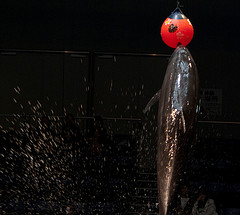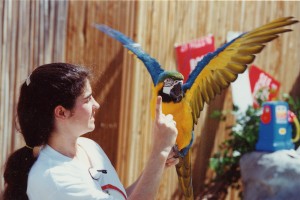
Photo property of Green Dog Pet Supply
We couldn’t believe it when we moved to Portland and saw/heard how many fireworks go off here on the 4th of July. We’ve never lived anywhere with legal fireworks, and had no idea that it would be such a constant barrage of explosions for hours on end. This can be a very frightening thing for pets in our homes who can’t possibly understand what is happening, and can drive some dogs into a panic. I thought I’d put together some tips for how to get ready and how to deal with the 4th when it comes.
If this is your first 4th of July with your new puppy, this is your chance to set the tone for the future. This exercise can also help older dogs that are already frightened of fireworks noises. <! — more — >
In the next week, try to desensitize the noise of random fireworks and turn them into a signal that something great is going to happen for the dog. People are always impatient for the 4th to come, and they end up setting a few off ahead of time. These can be very useful opportunities for you to work on getting your puppy happy with the noises instead of being frightened. First, get some sort of outrageous treat ready — something that will really blow your dog’s mind that they doesn’t usually get. Hotdog slices come to mind, or pieces of real meat. Cut them up and put them in a Tupperware in the front of the fridge, ready to grab. Any time you hear a bang outside, start your “puppy party”. React like something really exciting and fabulous has happened — “Lucky puppy!! Oooh Boy!” Bounce your way to the fridge and grab your goodies. Sounds silly, but if you’re lucky enough to get some repetitions, your dog will soon associate the sound of the fireworks with an opportunity for a hotdog puppy party, instead of making up their own interpretation of what this big noise could possibly mean. Dogs are incredibly good at associations, and this sort of classical conditioning works well with anything that a dog has previously found unnerving. They will quickly come to associate a noise (even a scary one) with big fun if that’s what you seem to be saying it means. An industrious puppy owner could even come up with ways of getting some more repetitions under their belt in ways they can control and predict. Maybe you can get a hold of some of those little tiny ones that you throw on the ground and they make a “snap!” sound. Then list the help of a friend or family member to set them off when you’re inside with your pup and your helper is outdoors. Cell phones make this an easier exercise. Get your treats ready not too far away, and tell your helper to set one off — just a little pop. “Lucky puppy”! It makes you happily jump up from the couch and get him a hotdog slice. Then you settle down again. When you’re ready, maybe a few more pops, and a few more hotdog slices and maybe a little game of tug, or a new toy and end the exercise. Just a few repetitions a night can lead to some good associations for your dog. If your dog has an extreme case of fireworks phobia, consider occasionally working on this exercise throughout the coming year, sometimes with very small fireworks that aren’t very obnoxious. (You especially don’t want your pet owning neighbors hate you!) and next year will be easy sailing for your dog. You might also be able to find a fireworks noises tape or CD, or use you tube to find something. In the cases of extreme fear, you want to start as small as possible — very low volume on the DVD. The key is to wait to increase the intensity until you get a good response at the level you’re at. It may seem like a pain, but it’s so worth it in the end to help spare them from such a stressful experience. You can also use this “Lucky Puppy!” response to help work on other noises for the noise sensitive dog. The other reason this works is that dogs play off of your energy. You might be inadvertently reinforcing the trembling terrors by being tense about fireworks yourself, whereas if you appear to think a noise is OK, or even fun, they might believe you (especially a puppy).
– Next, consider picking up a product to help ease the fear of a nervous dog. Our favorite products for calming are CBDs, available in treat or tincture form. Cats can also benefit from CBDs during these scary times. Animals Apawthecary makes an herbal blend for dogs and cats called Tranquility Blend to relax an animal, and Ark Naturals makes an herbal blend for dogs called Happy Traveler that might help to take the edge off. (We carry all three in the store, if you’re in the neighborhood). It is safe to combine CBDs with these other herbal products with animals that are truly terrorized by noises.
– On the day, make sure that you exercise your pets really well (wand toys for cats help a lot). A tired dog is much less likely to be stressed about the noises. Keep your pets inside, as more animals are lost on this night than almost any other trying to flee from the noise. If you’re not going to be home, find a secure place in the house and draw the blinds (if your dog is crate trained and feels safe in it, this would be a perfect time to use it).
– Some folks have told us that drowning out the noises sometimes helps. One woman said she puts her dog in the laundry room with a meaty bone or a stuffed Kong and puts sneakers in the dryer, and it works well for her dog. You’d have to decide though whether that would add stress to your noise sensitive dog, or whether it might help. Of course it depends on your dog. Perhaps more “normal” noises like the TV or radio would work better for some.
– Other people have had good luck with the T-Touch method of wrapping a dog in fabric to give it a greater sense of security. The easiest way to try this is to get a tight t-shirt, put it on the dog and tie the bottom in a knot to keep it snug around the dog’s body. (If it smells like you, even better.) We also carry Thundershirts, a product that helps you wrap them up in a jacket-type way.
Most importantly, don’t ever bring a dog with you to a fireworks display. Not only are they very crowded, but they are far too loud for your dog’s sensitive ears. While there are some dogs out there who might take an experience like a fireworks display in stride, it would be far too easy to traumatize a dog with this very extreme evening of smells, giant explosions overhead, the feeling of rumbling in the ground, and earsplitting noise. Once you’re packed into a crowd, it’s hard to make a quick exit if your dog isn’t handling the situation well, and the damage might already be done. Perhaps you could spend the puppy’s first 4th of July at home with him and make it a fun evening for him, so that future fireworks aren’t as scary.
Have any fireworks tips for others, or product recommendations? Please feel free to post a comment here and share your idea with others!




 dolphin that she can touch that ball on purpose to make that trainer give her another fish. Now that the intent is clear that the behavior is to touch the ball with her nose, the trainer can introduce a hand signal or word right before she touches it, which becomes the command. The trainer might suspend the ball from a rope right at water level, and ask for and whistle/reward touches to the ball. Then the ball can be raised a little at a time and the dolphin must now stretch to reach it, and then jump to reach it, etc. Targeting can also be used to teach her to touch other parts of her body to objects or even a trainer’s hand, allowing the trainer to perhaps shake a flipper (first a “trick”) and then this trick is used to slowly shape a far more difficult behavior, like allowing a vet to take blood from a vein on that flipper – all with voluntary participation from that dolphin. It removes the fear of that procedure as it’s taught gradually, and is certainly easier and much less risky for everyone involved than corralling that dolphin and herding her into some sort of restraint device that would enable them to get that blood sample forcefully, and good luck getting that done a second time! With positive reinforcement training, it became possible for trainers to get voluntary participation from the dolphins for complex behaviors like veterinary procedures, helping to greatly lower the stress for the dolphins if they needed care.
dolphin that she can touch that ball on purpose to make that trainer give her another fish. Now that the intent is clear that the behavior is to touch the ball with her nose, the trainer can introduce a hand signal or word right before she touches it, which becomes the command. The trainer might suspend the ball from a rope right at water level, and ask for and whistle/reward touches to the ball. Then the ball can be raised a little at a time and the dolphin must now stretch to reach it, and then jump to reach it, etc. Targeting can also be used to teach her to touch other parts of her body to objects or even a trainer’s hand, allowing the trainer to perhaps shake a flipper (first a “trick”) and then this trick is used to slowly shape a far more difficult behavior, like allowing a vet to take blood from a vein on that flipper – all with voluntary participation from that dolphin. It removes the fear of that procedure as it’s taught gradually, and is certainly easier and much less risky for everyone involved than corralling that dolphin and herding her into some sort of restraint device that would enable them to get that blood sample forcefully, and good luck getting that done a second time! With positive reinforcement training, it became possible for trainers to get voluntary participation from the dolphins for complex behaviors like veterinary procedures, helping to greatly lower the stress for the dolphins if they needed care. Most of my posts are about cats and dogs of course, as that is our primary focus at Green Dog. But I know some of you have birds out there, and today I ran across a few videos about bird training that seemed to really have value – I thought I’d pass along a few to you. (and anyone that enjoys training any species at all can learn from these videos, as the concepts of positive reinforcement training are remarkably similar between species. I’ve trained a lot of animals, from orangutans to rhinos using these exact same techniques, and they work like a dream on dogs and even cats).
Most of my posts are about cats and dogs of course, as that is our primary focus at Green Dog. But I know some of you have birds out there, and today I ran across a few videos about bird training that seemed to really have value – I thought I’d pass along a few to you. (and anyone that enjoys training any species at all can learn from these videos, as the concepts of positive reinforcement training are remarkably similar between species. I’ve trained a lot of animals, from orangutans to rhinos using these exact same techniques, and they work like a dream on dogs and even cats).
